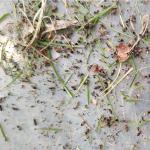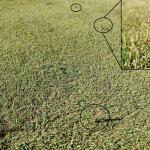Annual Bluegrass Weevil (ABW)
GDD accumulation (~90-100), plant phenology (Forsythia at or approaching half green, half gold) and increasing numbers of adults in samples from golf course fairways indicate that adult activity is peaking, and it is time for adulticide application in Southern New England. Starting in the second part of last week (week of 4/22) through this week (week of 4/29) is the time to apply adulticides if this application is planned. The recent drop in temperatures (especially at night) might have slowed down adult activity, but this is short-lived and does not significantly affect general trends of weevil activity.
Pyrethroids are the only chemical class registered for turf use as ABW adulticides. Unfortunately, many ABW populations in the region have developed resistance to this class of materials (O. Kostromytska, unpublished data) and the efficacy of any active ingredient within the class, and even efficacy of materials in other classes, can be negatively affected. Another application that can be made at this time is novaluron, which is an insect growth regulator (IGR). This active ingredient is mostly effective against eggs and young larvae but has demonstrated great efficacy if applied at the adulticide timing as well.
The recent general guideline for ABW management is to move away from adulticide application and focus on larvae management, considering the resistance issues and the different active ingredients availability for larvae control. In addition, and similar to last year, we are still observing relatively low ABW adult densities throughout the region. With low weevil activity, this is another reason to avoid pyrethroid use for adults and target larvae instead, and make decisions according to monitoring of pest densities.
Chinchbugs
 Chinchbug adults became active more than a week ago (Figure 1), however no nymphs were present yet. Despite the relatively wet spring, the numbers are pretty high in the area, likely based on last year’s infestation. Milder winter temperatures also would have favored chinchbug survival during overwintering. If an application against chinchbugs is needed, a June timing is advised in our region, and now is a good time to monitor their presence, abundance, and stage, especially if populations are present or suspected. This year’s wet spring is also conducive to the naturally occurring fungus Beauveria bassiana, and hopefully it will cause some mortality and reduce population numbers. However, if population densities are high, application of a pyrethroid or neonicotinoid clothianidin should be considered.
Chinchbug adults became active more than a week ago (Figure 1), however no nymphs were present yet. Despite the relatively wet spring, the numbers are pretty high in the area, likely based on last year’s infestation. Milder winter temperatures also would have favored chinchbug survival during overwintering. If an application against chinchbugs is needed, a June timing is advised in our region, and now is a good time to monitor their presence, abundance, and stage, especially if populations are present or suspected. This year’s wet spring is also conducive to the naturally occurring fungus Beauveria bassiana, and hopefully it will cause some mortality and reduce population numbers. However, if population densities are high, application of a pyrethroid or neonicotinoid clothianidin should be considered.
White grubs
White grubs have moved up in the soil profile (we are finding grubs within the top 2” of soil) and they have resumed feeding. If densities are high, you might see some additional primary damage (caused by grub feeding) and secondary damage (caused by predators looking for grubs) soon. Curative control of grubs in spring is usually not recommended, unless the high grub densities occur in highly valuable areas and no damage can be tolerated. If absolutely necessary, curative insecticides (trichlorfon, carbaryl, or clothianidin) can be used.
Chlorantraniliprole application is usually made at this time (from April 15 to June 15), however this application does not target large grubs feeding right now. This application targets small larvae which will hatch in July. This application aims to control the next, summer generation of grubs. It is recommended much earlier than adult flight and egg laying (which is the common timing recommendation for preventive neonicotinoid application) because it takes time for this active ingredient to be absorbed by turfgrass plants and it has a long residual activity. If other active ingredients for preventive grub application are used instead (for example, neonicotinoids) the correct timing is during the egg-laying, which will not occur until at least the beginning of July.
Craneflies
 The spring flight of the common cranefly, Tipula oleracea, was observed in Connecticut and Eastern Massachusetts last week (week of 4/22) (Figure 2). Common craneflies are one of two introduced, turf-damaging species which occur in our region. There are two generations per year; adults fly in spring (last week of April – first week of May) and complete the first generation by September. The second or winter generation larvae feed through fall, winter, and spring. We have received reports that most damage is observed in winter, when turf does not have the opportunity to recover.
The spring flight of the common cranefly, Tipula oleracea, was observed in Connecticut and Eastern Massachusetts last week (week of 4/22) (Figure 2). Common craneflies are one of two introduced, turf-damaging species which occur in our region. There are two generations per year; adults fly in spring (last week of April – first week of May) and complete the first generation by September. The second or winter generation larvae feed through fall, winter, and spring. We have received reports that most damage is observed in winter, when turf does not have the opportunity to recover.
Management should focus on targeting small larvae 2-3 weeks after adult flight. Almost all insecticide classes registered for use in turf can provide good control against young larvae, but become significantly less effective if applied against older larvae (data obtained in study against European craneflies by Peck et al 2009 and O.Kostromytska, unpublished data). Unlike common crane flies, European cranefly has only one generation per year, but we have not received any reports of damage, flight, or populations of this species in New England. Currently we are conducting research on management options against common craneflies, and reports on their activity will be helpful.
Ants
Turfgrass ant workers became active a week ago, and have been found in our samples, however we have not seen any mounds yet. Spring is the best time for ant management because the populations are weak and less abundant after overwintering. Turfgrass ants are usually only a significant problem on short cut grass (eg. golf courses), and ants in general are effective predators and should be managed only on high value short cut turf where problems are occurring.
Reference - Peck, D.C., Olmstead, D., and Morales, A. 2009. Insecticidal control of invasive craneflies in the northeastern U.S. GMC, March:120-126 pg.
Submitted by: Dr. Olga Kostromytska